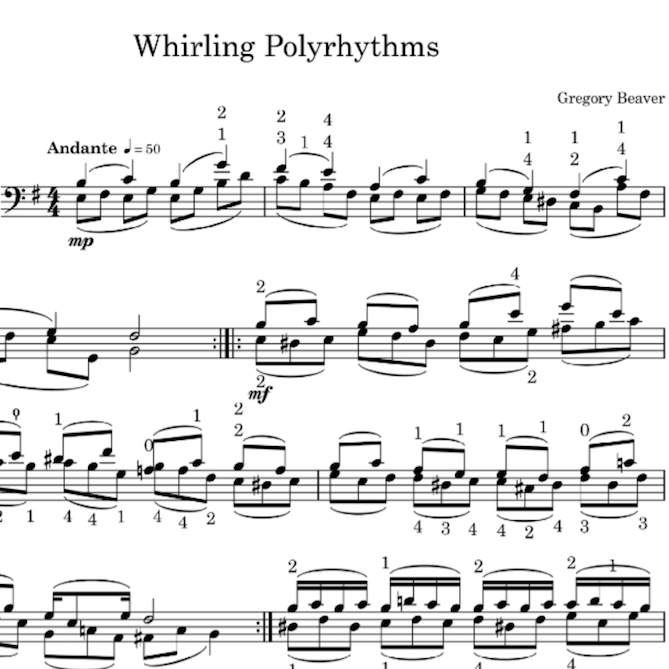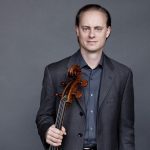
Introducing: Impossible Etudes and Possible Etudes for Cello!
Gregory Beaver
Etudes that fill a hole in the rep that are actually fun to play.
In the world of etudes for cello, there are many great etudes to choose from, whether it is the Duport, Popper, or my personal favorite, the Piatti. The Popper High School Op. 73 is particularly amazing for the range of cello technique it encompasses. In addition, its focus on chromaticism makes it very useful for developing the ear.
However, there are some holes in the etude literature that keep popping up. For example, the idea of finger independence while playing double stops is partially found in Piatti Caprices, but true finger independence is elusive for many of my students even after playing these etudes. Polyrhythms are a perfect vehicle for this challenge. Many contemporary works require a kind of shifting agility which defies traditional ideas of shifting (measuring the interval your arm will move and sliding to the note from the previous note with the hand), and more resembles the way we find notes in first position (just put the hand on the right note).
Other challenges I often see are students who are unable to use their vibrato speed to affect expression, inability to control the speed of ricochet, limited repertoire of expressive shifts/glissandi, ability to conceive of the entire hand position at once in thumb position (although Popper 33 begins to address this need), and a few more things. I’m looking forward to composing new etudes to fill these needs as well!
Because these challenges are so advanced, I’m calling this set of etudes my “Impossible Etudes.” Be forewarned, they are not for the faint of heart. However, advanced high school students have demonstrated the ability to play these works, so they should be accessible to the vast majority of college students majoring in performance.
For my less advanced students, I have noticed that etudes that are interesting tend to be either too difficult to execute successfully, or simply too boring to make the payoff worth the effort. For this group of students, I am working on a set of “Possible Etudes.” The first example included in this post is one I call “Spiccato” (one guess what technique that etude seeks to address, and the first guess doesn’t count).
Originally, “Spiccato” was written as a standalone work for cello, but in the first lesson that one of my students played it for me, she enjoyed it so much, I added a piano part. This etude is extremely silly, and is not designed to appeal to the intellectual side of students!
If you plan to use these etudes in your work, please post a reply! I am happy to provide remote lessons via Skype for those who want to start learning these etudes.
Impossible Etudes Shifting Mania.pdf
Impossible Etudes Whirling Polyrhythms.pdf
Possible Etudes Spiccato – Cello.pdf
Possible Etudes Spiccato – Piano.pdf
Originally published on gregorybeaver.com
 From the beginning of his work as a performer, cellist Gregory Beaver has been fascinated with the process of growth. This fuels his performing, teaching, and writing with a passion from 17 years of performing internationally with the Chiara String Quartet. It permeates his published writings in Strad Magazine, a book on computer programming, his contributions to the open source programming world and even his personal recipe for guacamole. After the Chiara Quartet concludes its performing activities in 2018, Mr. Beaver will take this passion and devote it to expanding his teaching activities.
From the beginning of his work as a performer, cellist Gregory Beaver has been fascinated with the process of growth. This fuels his performing, teaching, and writing with a passion from 17 years of performing internationally with the Chiara String Quartet. It permeates his published writings in Strad Magazine, a book on computer programming, his contributions to the open source programming world and even his personal recipe for guacamole. After the Chiara Quartet concludes its performing activities in 2018, Mr. Beaver will take this passion and devote it to expanding his teaching activities.
Teaching traditionally invokes the image of a staid classroom, clear curriculum and strict rules to be followed. Mr. Beaver is not interested in just conforming to what has been tried in the past. His experience in the bumpy career path of a professional string quartet illustrated quite clearly that a holistic understanding of life, art, and business is more energizing. His students have been on the receiving end of experiments for many years to help them develop the precise skills needed to unlock their true potential, as humans and ambassadors for their music, and not just as cellists. He is the author of several cello etudes called the “Impossible Etudes” and myriad exercises to fine-tune the specific needs of each student.
His writing touches on issues relating to self-awareness, on practicing effectiveness, on connecting to others more effectively in chamber music as well as poetry and larger issues with society and politics. Mr. Beaver writes for his blog, https://gregorybeaver.com, as well as CelloBello, where he is a regular guest on “cello chats.”
Before his professional life in the Chiara Quartet, Mr. Beaver studied with Joel Krosnick at the Juilliard School, and Norman Fischer at Rice University. He had the opportunity to work with great conductors such as Claudio Abbado, Pierre Boulez, Seiji Ozawa, played principal cello of the Tanglewood Music Center Orchestra, and won first prize at the Corpus Christi International Competition. He began his cello studies under Char Sherman as a Suzuki student and studied in high school with renowned pedagogue Louis Potter, jr. Mr. Potter studied with Willem Willeke at Juilliard, graduating in 1935. Mr. Willeke had a long and fruitful relationship with Johannes Brahms, perhaps explaining why Mr. Beaver feels an affinity for Brahms. Gregory loves to experience the completeness of things, and has performed cycles of Solo Bach, Beethoven Cello/Piano Sonatas, as well as Brahms, Beethoven, and Bartok cycles with the Chiara Quartet. He lives with his wife, Hyeyung Yoon, 2 daughters and cat in Lincoln, Nebraska.
Subjects: Repertoire
Tags: